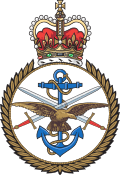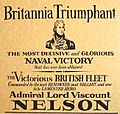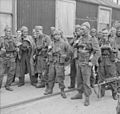British Armed Forces facts for kids
Quick facts for kids British Armed Forces |
|
|---|---|
 The tri-service badge |
|
| Established | 1707 |
| Parts | |
| Leadership | |
| Commander-in-Chief | Queen Elizabeth II |
| Prime Minister of the United Kingdom (de facto authority) Secretary of State for Defence |
Rt Hon Boris Johnson MP Rt Hon Philip Hammond MP |
| Chief of the Defence Staff | General Sir Nick Houghton |
| Serving soldiers | |
| Available to be a soldier |
14,607,725 males, age 15–49, 14,028,738 females, age 15–49 |
| Fit to be a soldier |
12,046,268 males, age 15–49, 11,555,893 females, age 15–49 |
| Active employees/soldiers | 150,000 active personnel |
| Reserve personnel | 82,000 regular reserve |
| Expenditures | |
| Budget | FY 2013-14: GBP £36.3 billion |
| Percent of GDP | 2.1% |
The British Armed Forces are the military forces of the United Kingdom. They are officially known as Her Majesty's Armed Forces. Sometimes, people also call them the Armed Forces of the Crown. These forces are made up of three main parts: the British Army, the Royal Navy (which includes the Royal Marines), and the Royal Air Force.
Contents
Who Leads the British Armed Forces?
The official leader, or Commander-in-Chief, of the British Armed Forces is the British monarch. Currently, this is Queen Elizabeth II. When people join the armed forces, they promise to obey the monarch's orders. This promise is called swearing allegiance.
How Does Parliament Control the Military?
Even though the monarch is the official head, the British military is controlled by the Crown. However, because of a law from 1689 called the 1689 Bill of Rights, the UK cannot have a standing army during peacetime unless the British Parliament agrees.
Today, Parliament passes a law called the Armed Forces Act every five years. This law allows the UK to keep its military. The Prime Minister is the person who actually makes decisions for the British Armed Forces. The whole military is managed by the Ministry of Defence.
What Do the British Armed Forces Do?
The main job of the British Armed Forces is to protect the United Kingdom. They also protect the British overseas territories and the Crown dependencies. These are places around the world that are part of or linked to the UK.
Where Do They Operate?
The British Armed Forces also work with other countries. They often join United Nations peacekeeping missions. They are also a big part of NATO, which is a group of countries that work together for defense.
In recent times, the British Armed Forces have fought in wars in Afghanistan and Iraq. They have also helped with peacekeeping in places like the Balkans and Cyprus. They even helped to protect the skies over Libya.
Where Are Their Bases?
The British Armed Forces have military bases in many different places around the world. These include:
- Ascension Island
- Belize
- Brunei
- Canada
- Diego Garcia
- the Falkland Islands
- Germany
- Gibraltar
- Kenya
- Qatar
- the Sovereign Base Areas in Cyprus
Does the UK Have Nuclear Weapons?
Yes, the United Kingdom has nuclear weapons. They first tested a nuclear weapon in 1952 during something called Operation Hurricane. As of 2012, Britain is one of the five countries officially allowed to have nuclear weapons under the Nuclear Non-Proliferation Treaty.
The UK has about 225 nuclear warheads. These powerful weapons are controlled by the Royal Navy.
Images for kids
-
A modern poster remembering the Battle of Trafalgar from 1805.
-
Soldiers from the Royal Irish Rifles in the trenches during the Battle of the Somme in 1916.
-
The Vulcan Bomber was a key part of Britain's nuclear air power during the Cold War.
-
Queen Elizabeth II, as Commander-in-Chief, riding her horse Burmese at the 1986 Trooping the Colour ceremony.
-
The Ministry of Defence building in Whitehall, Westminster, London.
-
Welsh Guards performing the Trooping the Colour ceremony.
-
The Challenger 2 main battle tank.
-
The Eurofighter Typhoon, a multi-role combat aircraft used by the Royal Air Force.
See also
 In Spanish: Fuerzas Armadas británicas para niños
In Spanish: Fuerzas Armadas británicas para niños
















